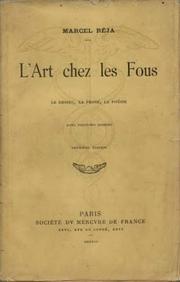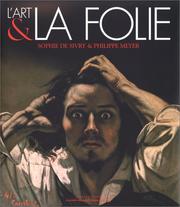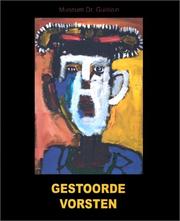| Listing 1 - 10 of 10 |
Sort by
|
Book
Year: 1967 Publisher: Springfield, Ill. : C. C. Thomas,
Abstract | Keywords | Export | Availability | Bookmark
 Loading...
Loading...Choose an application
- Reference Manager
- EndNote
- RefWorks (Direct export to RefWorks)

ISBN: 2738492797 Year: 2001 Publisher: Paris Montréal L'Harmattan
Abstract | Keywords | Export | Availability | Bookmark
 Loading...
Loading...Choose an application
- Reference Manager
- EndNote
- RefWorks (Direct export to RefWorks)
Book
ISBN: 9789082363401 Year: 2015 Publisher: Herzele Lucinda Ra
Abstract | Keywords | Export | Availability | Bookmark
 Loading...
Loading...Choose an application
- Reference Manager
- EndNote
- RefWorks (Direct export to RefWorks)
Psychiatry in art --- Hulpverlening --- Psychiatrische centra --- Alternatieve hulpverlening --- Kunstenaars --- Therapie --- Jeugd --- Kinder- en jeugdpsychiatrie --- Residentiële zorg --- Psychiatrisch centrum --- Kunstenaar --- Jongere
Book
Abstract | Keywords | Export | Availability | Bookmark
 Loading...
Loading...Choose an application
- Reference Manager
- EndNote
- RefWorks (Direct export to RefWorks)
mythomaniaS is a catalog of case studies in the form of film stills, architectural fragments, stage props, texts, and images culled from the experiments of MindMachineMakingMyths (Lab M4, part of the New Territories architecture studio, Bankgok, Thailand), a collaboration begun in 2012 between Camille Lacadee and François Roche to construct environmental-architectural psycho-scapes as laboratory-shelters for exploring and deconstructing the supposed rifts between realism and speculative fiction (myth), psyche and environment, body and mind. Bringing together architecture, Deleuze and Guatarri's schizoanalysis and deterritorialization, and Alfred Jarry's pataphysics (the "science of imaginary solutions which symbolically attributes the properties of objects, described by their virtuality, to their lineaments"), Lacadee and Roche (and their tribe, Ezio Blasetti, Stephan Henrich, Danielle Willems, Gwyll Jahn, and many others) enacted and filmed mise-en-abymes in which certain scripted para-psychic narratives and architectural structures merge in the pursuit of reclaiming resilience -- described by Roche as a tactic for merging refusal and vitality into a schizophrenic logic able to navigate the antagonism between the bottom-up and top-down conditions of the globalized world. In these fabricated schizoid psycho-nature-machine-scapes, the human being is no longer a bio-ecological consumer but a psycho-computing animal that emerges co-dependently with its environment in a hyper-local haecceity ("this-ness"). In the vein of Situationist psychogeography ("the study of the precise laws and specific effects of the geographical environment, consciously organized or not, on the emotions and behavior of individuals"), each scenario fabulates geo-architectural conditions of human exile, solitude, and pathology drawn from narratives of the forbidden and taboo: the true story of an old Indian book collector exiled from his community on the suspicion of atheism, who finds refuge in a tear-collecting shelter ("Would Have Been My Last Complaint"); a scientist captured by a water spirit who remains trapped like a fish in the mindscape of a fish butcher (Although (in) Hapnea); a monster-boy endomorph constantly overfed and protected by a claustrophilic antidote-jacket produced by the excess of his incestuous mother's love ((beau)strosity); Ariadne, labyrinth overseer, floating between two macho spirals, testosteroned Theseus and alcoholic Dionysus (Naxos, Terra Insola); the feral child -- innocent, naïve, and obscene -- in the deep jungle, auscultated by a scientistic voyeurism (The Offspring); etc. Each of these scenarios (designed as "shelters" where mind, environment, and architecture co-map each other) unfolds a "mythomania" in which each character transforms, and is transformed, para-psychically, by the environment, in a sort of biotope (habitat) feedback experiment. Ultimately, Lacadee and Roche want to create -- via architecture and design, myth (literature), and psycho-geography -- various conditions for schizoid passages between realism and fiction, expertise and knowledge, mind and built environment, narrative and topology, in order to bring about new strategic-tragic co-dependencies as forms of schizoid resistance to the usual identity regimes, and to also reboot architecture as a form of psycho-social praxis and non-necrotic speculation.
Art and mental illness. --- Psychology in art. --- Psychiatry in art. --- Psychoanalysis and art. --- Psychoanalysis and architecture. --- Theatre studies
Book
Abstract | Keywords | Export | Availability | Bookmark
 Loading...
Loading...Choose an application
- Reference Manager
- EndNote
- RefWorks (Direct export to RefWorks)
mythomaniaS is a catalog of case studies in the form of film stills, architectural fragments, stage props, texts, and images culled from the experiments of MindMachineMakingMyths (Lab M4, part of the New Territories architecture studio, Bankgok, Thailand), a collaboration begun in 2012 between Camille Lacadee and François Roche to construct environmental-architectural psycho-scapes as laboratory-shelters for exploring and deconstructing the supposed rifts between realism and speculative fiction (myth), psyche and environment, body and mind. Bringing together architecture, Deleuze and Guatarri's schizoanalysis and deterritorialization, and Alfred Jarry's pataphysics (the "science of imaginary solutions which symbolically attributes the properties of objects, described by their virtuality, to their lineaments"), Lacadee and Roche (and their tribe, Ezio Blasetti, Stephan Henrich, Danielle Willems, Gwyll Jahn, and many others) enacted and filmed mise-en-abymes in which certain scripted para-psychic narratives and architectural structures merge in the pursuit of reclaiming resilience -- described by Roche as a tactic for merging refusal and vitality into a schizophrenic logic able to navigate the antagonism between the bottom-up and top-down conditions of the globalized world. In these fabricated schizoid psycho-nature-machine-scapes, the human being is no longer a bio-ecological consumer but a psycho-computing animal that emerges co-dependently with its environment in a hyper-local haecceity ("this-ness"). In the vein of Situationist psychogeography ("the study of the precise laws and specific effects of the geographical environment, consciously organized or not, on the emotions and behavior of individuals"), each scenario fabulates geo-architectural conditions of human exile, solitude, and pathology drawn from narratives of the forbidden and taboo: the true story of an old Indian book collector exiled from his community on the suspicion of atheism, who finds refuge in a tear-collecting shelter ("Would Have Been My Last Complaint"); a scientist captured by a water spirit who remains trapped like a fish in the mindscape of a fish butcher (Although (in) Hapnea); a monster-boy endomorph constantly overfed and protected by a claustrophilic antidote-jacket produced by the excess of his incestuous mother's love ((beau)strosity); Ariadne, labyrinth overseer, floating between two macho spirals, testosteroned Theseus and alcoholic Dionysus (Naxos, Terra Insola); the feral child -- innocent, naïve, and obscene -- in the deep jungle, auscultated by a scientistic voyeurism (The Offspring); etc. Each of these scenarios (designed as "shelters" where mind, environment, and architecture co-map each other) unfolds a "mythomania" in which each character transforms, and is transformed, para-psychically, by the environment, in a sort of biotope (habitat) feedback experiment. Ultimately, Lacadee and Roche want to create -- via architecture and design, myth (literature), and psycho-geography -- various conditions for schizoid passages between realism and fiction, expertise and knowledge, mind and built environment, narrative and topology, in order to bring about new strategic-tragic co-dependencies as forms of schizoid resistance to the usual identity regimes, and to also reboot architecture as a form of psycho-social praxis and non-necrotic speculation.
Art and mental illness. --- Psychology in art. --- Psychiatry in art. --- Psychoanalysis and art. --- Psychoanalysis and architecture. --- Theatre studies
Book
Abstract | Keywords | Export | Availability | Bookmark
 Loading...
Loading...Choose an application
- Reference Manager
- EndNote
- RefWorks (Direct export to RefWorks)
mythomaniaS is a catalog of case studies in the form of film stills, architectural fragments, stage props, texts, and images culled from the experiments of MindMachineMakingMyths (Lab M4, part of the New Territories architecture studio, Bankgok, Thailand), a collaboration begun in 2012 between Camille Lacadee and François Roche to construct environmental-architectural psycho-scapes as laboratory-shelters for exploring and deconstructing the supposed rifts between realism and speculative fiction (myth), psyche and environment, body and mind. Bringing together architecture, Deleuze and Guatarri's schizoanalysis and deterritorialization, and Alfred Jarry's pataphysics (the "science of imaginary solutions which symbolically attributes the properties of objects, described by their virtuality, to their lineaments"), Lacadee and Roche (and their tribe, Ezio Blasetti, Stephan Henrich, Danielle Willems, Gwyll Jahn, and many others) enacted and filmed mise-en-abymes in which certain scripted para-psychic narratives and architectural structures merge in the pursuit of reclaiming resilience -- described by Roche as a tactic for merging refusal and vitality into a schizophrenic logic able to navigate the antagonism between the bottom-up and top-down conditions of the globalized world. In these fabricated schizoid psycho-nature-machine-scapes, the human being is no longer a bio-ecological consumer but a psycho-computing animal that emerges co-dependently with its environment in a hyper-local haecceity ("this-ness"). In the vein of Situationist psychogeography ("the study of the precise laws and specific effects of the geographical environment, consciously organized or not, on the emotions and behavior of individuals"), each scenario fabulates geo-architectural conditions of human exile, solitude, and pathology drawn from narratives of the forbidden and taboo: the true story of an old Indian book collector exiled from his community on the suspicion of atheism, who finds refuge in a tear-collecting shelter ("Would Have Been My Last Complaint"); a scientist captured by a water spirit who remains trapped like a fish in the mindscape of a fish butcher (Although (in) Hapnea); a monster-boy endomorph constantly overfed and protected by a claustrophilic antidote-jacket produced by the excess of his incestuous mother's love ((beau)strosity); Ariadne, labyrinth overseer, floating between two macho spirals, testosteroned Theseus and alcoholic Dionysus (Naxos, Terra Insola); the feral child -- innocent, naïve, and obscene -- in the deep jungle, auscultated by a scientistic voyeurism (The Offspring); etc. Each of these scenarios (designed as "shelters" where mind, environment, and architecture co-map each other) unfolds a "mythomania" in which each character transforms, and is transformed, para-psychically, by the environment, in a sort of biotope (habitat) feedback experiment. Ultimately, Lacadee and Roche want to create -- via architecture and design, myth (literature), and psycho-geography -- various conditions for schizoid passages between realism and fiction, expertise and knowledge, mind and built environment, narrative and topology, in order to bring about new strategic-tragic co-dependencies as forms of schizoid resistance to the usual identity regimes, and to also reboot architecture as a form of psycho-social praxis and non-necrotic speculation.
Art and mental illness. --- Psychology in art. --- Psychiatry in art. --- Psychoanalysis and art. --- Psychoanalysis and architecture. --- Theatre studies --- Theatre studies

ISBN: 2843241235 Year: 1998 Publisher: Paris : Sextant bleu,
Abstract | Keywords | Export | Availability | Bookmark
 Loading...
Loading...Choose an application
- Reference Manager
- EndNote
- RefWorks (Direct export to RefWorks)
Psychiatry in art --- Art and mental illness --- Painting, European --- Painting, Modern --- Psychiatrie dans l'art --- Art et maladies mentales --- Peinture européenne --- Peinture moderne
Book
ISBN: 385409163X 3854091605 Year: 1989 Volume: 123] Publisher: Wien Wiener Festwochen
Abstract | Keywords | Export | Availability | Bookmark
 Loading...
Loading...Choose an application
- Reference Manager
- EndNote
- RefWorks (Direct export to RefWorks)
Art --- anno 1800-1899 --- Art, Modern --- Psychiatry in art --- Psychology in art --- Soul in art --- Art moderne --- Psychiatrie dans l'art --- Psychologie dans l'art --- Esprit dans l'art --- Exhibitions --- Expositions --- Ensor, James: Zelfportret, 0000-0000 (2712/219 R). --- Kunst. --- Tentoonstellingscatalogus. --- anno 1800-1899.
Book
ISBN: 9789401403788 Year: 2012 Publisher: Tielt Lannoo
Abstract | Keywords | Export | Availability | Bookmark
 Loading...
Loading...Choose an application
- Reference Manager
- EndNote
- RefWorks (Direct export to RefWorks)
Vrouwen worden al eeuwenlang als 'nerveuzer' beschouwd dan mannen, eerder ten prooi aan labiliteit en geestesziekte, vaker lastiggevallen door geesten en demonen. Maar zijn zij nu ook in werkelijkheid 'zieker van geest'? In de negentiende eeuw leken sommige vrouwen waanzinnig te worden door een gebrek aan gedragsvrijheid. Begin eenentwintigste eeuw lijken sommige vrouwen juist te bezwijken onder de last van de 'vrijheid'. Het beeld bestaat dat de eisen die de samenleving hen oplegt om carrière te maken, er prachtig uit te zien en een flitsend sociaal leven te leiden hen te veel wordt. Maar is dit wel zo? De tentoonstelling presenteert zeven 'koppels' patiënte-psychiater: een merkwaardige geschiedenis van hoe de samenleving en de psychiatrie evolueert, van hoe bepaalde ziektebeelden zoals hysterie tijdsgebonden fenomenen zijn, van hoe onze tijd nieuwe vormen van gestoord gedrag uitlokt en verdraagt. Nerveuze vrouwen wil het debat over de 'specifieke' positie van de vrouw in de psychiatrie stofferen. Nerveuze vrouwen is een tentoonstelling die het heeft over manie, melancholie, zwakke zenuwen, theatrale tics, hartstochtelijke liefde, zelfverminking, verveling, rebellie, zelfuithongering. Eric De Volder, Diane Arbus, Yayoi Kusama, Tracey Emin, Delphine Boël, Anne-Mie Van Kerckhoven, Paul McCarthy, Kati Heck, Barbara Krüger, Cindy Sherman, Viviane Joakim, Markus Schinwald, Hans-Peter Feldmann, Madge Gill, Weegee, Gao Brothers, Lili Dujourie, Guerrilla Girls, Alfons Mucha, Louise Bourgeois, Gertrud Schwyzer, Félicien Rops, Unica Zürn, Nobuyoshi Araki, Annie Sprinkle, Ann Huybens, Zoulika Bouabdellah, Eleanor Antin, Philip Huyghe, Elodie Antoine, Tracey Snelling, Shadi Ghadirian, Luc Tuymans, ...
Psychiatrists. --- Women. --- Museum Dr. Guislain (Ghent) --- psychiatrie --- mentally ill --- Psychiatry --- Sociology of the family. Sociology of sexuality --- women [female humans] --- personen met een mentale beperking --- vrouwenpsychologie --- outsider art --- vrouwengeschiedenis --- art [fine art] --- History of human medicine --- psychiatry --- Théroigne de Méricourt, Anne J. --- Zürn, Unica --- Fromm-Reichmann, Frieda --- Barnes, Mary --- Monroe, Marilyn --- anno 1800-1999 --- anno 2000-2009 --- Kunst --- Exhibitions --- History --- Relations médecin-patient --- Psychiatry in art --- Sociologie van het gezin. Sociologie van de seksualiteit --- Geschiedenis van de menselijke geneeskunde --- Psychiatrie --- kunst --- outsiderkunst --- geesteszieken --- vrouwen --- 606.2 --- 418.12 --- 78.04.3 Gent --- Théroigne de Méricourt, Anne-Josèphe --- Vrouwen --- Provincie West-Vlaanderen --- Vrouw --- Ondernemerschap --- Poëzie --- art [discipline] --- Mental health care --- Gender --- Assistance --- Psychological vulnerabilities --- Images of women --- Book

ISBN: 9076745013 Year: 1999 Publisher: Gent
Abstract | Keywords | Export | Availability | Bookmark
 Loading...
Loading...Choose an application
- Reference Manager
- EndNote
- RefWorks (Direct export to RefWorks)
Tentoonstelling in het kader van het Keizer Karel herdenkingsjaar 1500 - 2000
Art --- Aliénation mentale --- Catalogues d'expositions --- Krankzinnigheid --- Souverains --- Tentoonstellingscatalogi --- Vorsten --- Mental illness --- Psychiatry in art --- Power (Social sciences) --- Power (Social sciences) in art --- Heads of state --- Psychiatrie dans l'art --- Exhibitions. --- Mental health --- Expositions --- historische figuren --- vorsten --- narren --- portretten --- macht --- waanzin --- Karel V (Keizer van het Heilig Roomse Rijk) --- George III (koning van Groot-Brittannië) --- Geschiedenis --- Geschiedenis (psychiatrie) --- Psychiatrie --- Creativiteit bij personen met een verstandelijke handicap --- Psychiatrie: geschiedenis (geschiedenis van de psychiatrie) --- Kunst --- 7.041 --- 340.63 --- Iconografie: de mens; portret; handeling; genre --- Expertise inzake toerekeningsvatbaarheid --- Exhibitions --- 340.63 Expertise inzake toerekeningsvatbaarheid --- 7.041 Iconografie: de mens; portret; handeling; genre --- hofnar --- emotionele ziektes, waanzin, krankzinnigheid --- Karel V (Keizer van het Heilig Roomse Rijk). --- George III (koning van Groot-Brittannië).
| Listing 1 - 10 of 10 |
Sort by
|

 Search
Search Feedback
Feedback About UniCat
About UniCat  Help
Help News
News